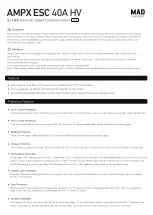
60
Importing Log Files into Other Applications
If you want to be able to import AMS log files into other programs, such as MATLAB or Microsoft Excel, you need
to have the AMS write log files in comma-delimited format (also called comma-separated-values, or CSV, files), as
well as the standard binary
.amvdata
file format. Note that only relatively short files (65,000 readings, or about
one-
minute’s worth) can be imported into Excel.
When you set MultiView to record CSV files, MultiView records both the
.amvdata
file and a
.csv
file. Data written
to the
.amvdata
file is in g-force units with no filtering. Data written to the
.csv
file has been filtered (if filtering is
active), and is converted to the units for the currently set time-domain format (see
on page
and
Changing the Time-Domain Format
At the top of the file, MultiView writes a file header including the AMS serial number, and the current settings for
the filter and time-domain format. Each line of data consists of six entries: RMS, X, Y, Z, Time, and Marks with
annotations, if any. You can choose to have the header information recorded at the end of the file, instead of at
the beginning (see
Importing Log Files into Other Applications
on page
), which can be useful for importing the
data into some applications.
The comma-delimited files are named as described in
on page
, but with two
differences, as follows.
•
The file extension is
.csv
, rather than
.amvdata
.
•
The filter settings are appended to the log file name, as shown below.
HW123456
2016-05-21
15-47-39
BandPass 1Hz~5Hz.csv
The AMS includes a sample Script M-file that you can use to import files into MATLAB to generate a Fast Fourier
Transform frequency analysis. The file is
AvsFft.m
and is located in the
\Program Files\ CyberOptics
Semiconductor\WaferSense AMS\Matlab
folder.
















































